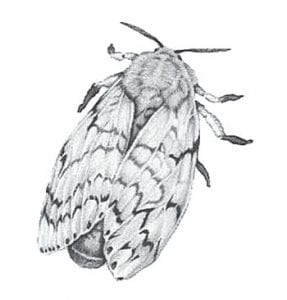Northlanders are becoming used to seeing little triangles of cardboard tacked to trees in the remotest of locations. After more than 10 years of gypsy moth monitoring, most people know that these are moth traps, put in place by the Minnesota Department of Agriculture (MDA). In December, MDA announced its gypsy moth monitoring program caught almost 28,000 moths in 2009–more than twice the previous high of 12,000 moths caught in 2008. Nearly 99 percent of the moths collected were in traps in northeastern Minnesota’s St. Louis, Lake and Cook counties.
According to MDA Plant Protection Division Director Geir Friisoe, the reason for the increase in moth numbers remains unclear.
“We’re probably seeing a combination of natural spread and accidental introduction by people moving infested materials in from states to the east or from Canada,” Friisoe said. “We’ve conducted several gypsy moth treatments in northeastern Minnesota in recent years, and the evidence shows we’ve had success controlling the population in the areas we’ve treated. Unfortunately, the moths keep coming.”
Gypsy moths (Lymantria
dispar L.)
are among the most destructive tree pests in North America, and they are well established from the East Coast to central Wisconsin. Gypsy moth caterpillars can defoliate large sections of forest, with oak, poplar, birch and willow among their preferred hosts. MDA monitors for the pests each year by attaching thousands of cardboard box traps to trees or poles around the state. In early fall, workers remove the traps and count the moths inside. MDA set 23,693 traps this year, and caught 27,870 moths.
When MDA finds a large number of moths in an area, it conducts treatments to eliminate the infestation or slow its establishment. In 2009, MDA treated a total of about 717 acres of land on the North Shore with a biological insecticide called Btk and about 71,000 acres with mating disruption (achieved by flooding an area with a synthetic sex-attractant (pheromone) just prior to when the moths emerge as adults). Seven treatment blocks were conducted, named for their geographic locations: Castle Danger, Split Rock Point, Carlton Creek, Onion River, Alfred Creek, Spruce Creek, and Hovland.
Those areas are being evaluated to determine the effectiveness of the treatments, with results expected in 2010.
MDA will work with federal, state and local partners to develop treatment plans in response to the latest monitoring results. As always, residents of affected areas and other interested parties will have the opportunity to review and comment on draft treatment plans before they are finalized. More information about gypsy moths and MDA’s control efforts can be found online at www.mda.state. mn.us/gypsymoth.



Loading Comments